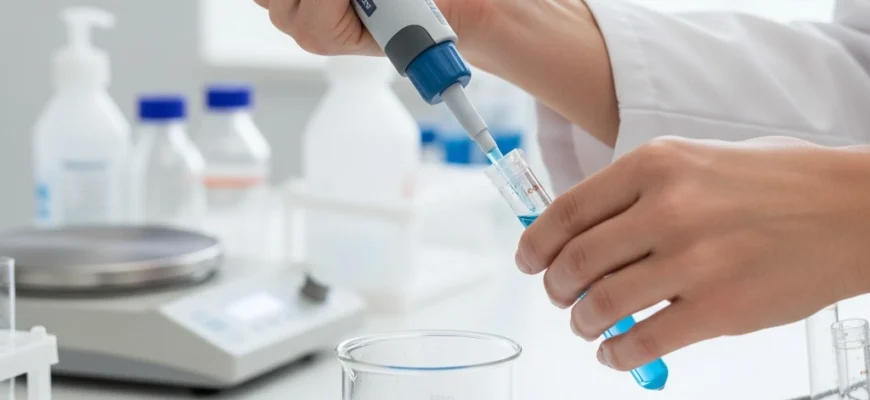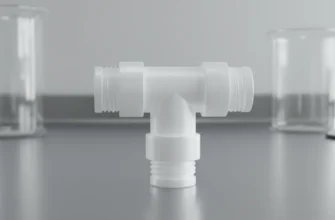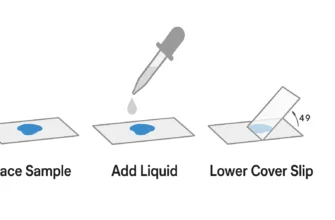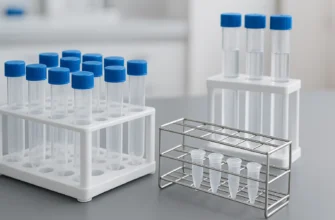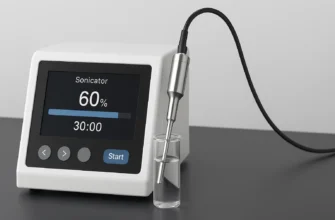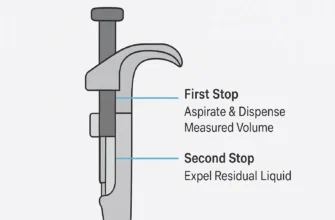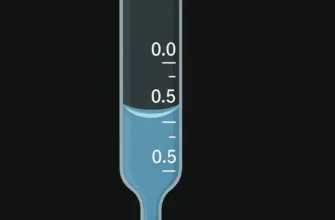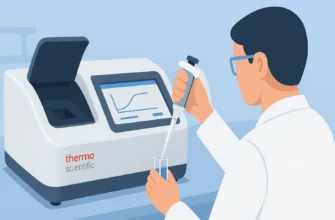In the modern laboratory setting, the pursuit of accurate and repeatable results is paramount. At the heart of this quest lies a fundamental skill: liquid handling. While standard forward pipetting is the workhorse for most tasks involving aqueous solutions, it falls short when faced with challenging liquids. This is where mastering an advanced pipetting technique becomes essential. Reverse pipetting is a powerful method designed to enhance accuracy and precision when working with viscous, volatile, or foaming samples. This guide will provide a comprehensive overview of the reverse pipetting technique, its ideal applications, and the essential tips required to achieve mastery.
Understanding Your Pipetting Tools: A Guide to Pipette Types
Effective liquid handling begins with selecting the right tool for the job. The vast majority of pipettes used in laboratories are air displacement pipettes. These instruments operate using a piston-driven air displacement mechanism: the internal piston moves to create a vacuum, and the resulting air cushion aspirates and dispenses the liquid. This design is highly effective for standard tasks but can be influenced by liquid properties and environmental conditions.
Pipettes come in several forms to suit different applications:
- Manual Pipettes: These are the most common type, requiring the user to operate the plunger by hand. They offer excellent control but rely heavily on user skill for consistency. They include both Single Channel Pipettes for individual samples and Multichannel Pipettes for processing multiple samples simultaneously, such as in 96-well plates.
- Electronic Pipettes: These motorize the piston’s movement, offering programmable volumes, speeds, and functions, including pre-set reverse pipetting modes. They significantly reduce user-to-user variability and physical strain, which is crucial given that close to 60 percent of respondents attribute human error as the major source of problems in their pipette performance.
- Positive Displacement Pipettes: Unlike air displacement models, these use a disposable piston that makes direct contact with the liquid. This eliminates the air cushion, making them the superior choice for extremely viscous or volatile liquids where air displacement methods may fail. However, for most challenging liquids, mastering reverse pipetting with an air displacement pipette is sufficient and more cost-effective.
Core Pipetting Techniques for Uncompromised Accuracy and Precision
Understanding the mechanical differences between forward and reverse pipetting is crucial for deciding when to use each method. Both techniques rely on the precise operation of a two-stop plunger.
Forward Pipetting: The Standard Approach
Forward Pipetting is the default technique for most applications, especially with non-viscous, aqueous solutions.
- Aspiration: Depress the plunger to the first stop. Immerse the pipette tip just below the surface of the liquid and release the plunger smoothly to aspirate the set volume.
- Dispensing: Place the tip against the inner wall of the receiving vessel. Depress the plunger to the first stop to dispense the liquid, then press it to the second stop—the blowout step—to expel any remaining fluid from the tip.
This method is fast and efficient but can be inaccurate with problematic liquids, as residual film may cling to the inner wall of the pipette tip after the blowout.
Reverse Pipetting: The Precision Technique
Reverse Pipetting is designed to compensate for the effects of viscosity, surface tension, and vapor pressure, ensuring that the correct volume is dispensed even when a residual film is left behind.
- Aspiration: Depress the plunger completely to the second stop (the blowout position). Immerse the tip into the source liquid and slowly release the plunger to its resting position. This action aspirates the set volume plus an excess amount equal to the blowout volume.
- Dispensing: Move the tip to the receiving vessel. Gently and smoothly depress the plunger to the first stop only. This accurately dispenses the volume set on the pipette.
- Residual Liquid: A small amount of liquid will remain in the pipette tip. This is the excess volume that was aspirated initially. This residual liquid should be discarded with the tip or returned to the source container if permitted. Do not perform the blowout step into your sample.
By aspirating an excess and dispensing only the target volume, the technique ensures that any film that coats the tip wall does not affect the final dispensed volume.
Advanced Strategies for Difficult Samples and Environmental Factors
The true value of the reverse pipetting technique emerges when handling liquids that defy standard methods. Choosing this approach strategically can dramatically improve data quality.
Viscous Liquids and High Viscosity Solutions
Liquids with high viscosity, such as glycerol, detergents, or concentrated BSA solutions, flow slowly and tend to cling to surfaces. During forward pipetting, this clinging effect causes a significant portion of the sample to remain in the pipette tips, leading to inaccurate, under-delivered volumes. Reverse pipetting circumvents this by pre-emptively accounting for the liquid that will be left behind. Research shows the tangible benefits of this approach; for example, one study found that when pipetting a 1% BSA solution, the reverse technique reduced imprecision by over 50% compared to forward pipetting. Similarly, cold liquids, which exhibit increased viscosity, are also ideal candidates for this method.
Volatile Liquids and Compounds
A volatile compound is one that evaporates easily, creating high vapor pressure inside the air cushion of a pipette. In forward pipetting, this pressure can cause the liquid to leak out of the tip before dispensing, resulting in volume loss. Reverse pipetting helps mitigate this issue. By aspirating an excess volume, the technique provides a buffer against evaporative loss. For best results with a volatile liquid, pre-wet the tip several times by aspirating and dispensing the liquid back into the source container. This saturates the air cushion with vapor, stabilizing the pressure and minimizing evaporation during the actual measurement.
Foaming Solutions and Small Volumes
Solutions containing proteins or detergents are prone to foaming, and the aggressive blowout step in forward pipetting can introduce bubbles and cause splashing. Reverse pipetting’s gentle dispensing action (stopping at the first stop) minimizes this turbulence. This controlled dispensing also makes it an excellent choice for accurately handling small volumes, where even minuscule errors from splashing or residual film can represent a large percentage of the target volume.
The Science Behind the Success: Why Techniques Work
The efficacy of reverse pipetting is rooted in fluid dynamics. The key challenge in liquid handling is managing the interplay between cohesive forces (liquid molecules sticking to each other) and adhesive forces (liquid molecules sticking to the pipette tip surface).
When pipetting liquids with high surface tension or viscosity, a thin film of liquid adheres to the inner surface of the polypropylene tip. In forward pipetting, the blowout step attempts to force this film out, but it’s often incomplete and inconsistent. This leads to variability in the dispensed volume.
Reverse pipetting solves this by incorporating the residual film into its calculation. When you aspirate to the second stop, you draw up the target volume plus a buffer. Upon dispensing to the first stop, the piston travels a precise distance to push out only the target volume. The residual film remains inside the tip, along with the buffer volume, and is discarded. The key is that the amount of liquid left behind as film is consistent so long as aspiration speed and immersion are controlled. The technique effectively standardizes the error, making the final dispensed volume highly accurate and repeatable.
Maintaining Pipette Performance: Calibration, Care, and Troubleshooting
Even the best pipetting technique cannot compensate for a poorly maintained instrument. Pipette performance is the foundation of reliable data. A startling report suggests that up to 30 percent of pipettes in service may not be performing within tolerance, underscoring the critical need for routine maintenance.
Essential Best Practices
- Pipette Calibration: Regular pipette calibration is non-negotiable. It verifies that the pipette dispenses the volume indicated on its display. Calibration should be performed by a qualified technician at least annually, or more frequently depending on usage and laboratory SOPs.
- Proper Tip Fit: Always use high-quality pipette tips recommended by the pipette manufacturer. A poor seal between the tip and the tip cone is a major source of inaccuracy, allowing air to leak and disrupting the aspiration volume.
- Routine Checks: Before use, visually inspect the pipette for any damage. Check the piston for smoothness of movement and ensure the tip ejector works correctly.
- Cleaning and Storage: Clean your pipettes regularly according to manufacturer instructions. Always store them upright in a stand to prevent liquid from running into the internal mechanism.
Integrating Pipetting into Modern Laboratory Workflows
Mastery of pipetting techniques is not just about manual dexterity; it’s about integrating smart strategies into broader workflows to enhance efficiency and reliability. The use of a multichannel pipette with the reverse technique, for example, allows for the accurate and simultaneous transfer of viscous reagents into a microplate, saving time without sacrificing precision.
Furthermore, modern electronic pipettes often have dedicated reverse pipetting modes that automate the plunger stops, simplifying the process and ensuring consistency across all users and samples. This level of control is a key driver behind automation in labs, where robotic systems have been shown to reduce turnaround times by 35%. By understanding and applying techniques like reverse pipetting, laboratories can better leverage these advanced tools to generate more reliable data faster.
Conclusion: The Path to Pipetting Mastery
Mastering liquid handling is a continuous journey, and reverse pipetting is a critical skill for any scientist striving for the highest level of accuracy. While forward pipetting remains the standard for simple aqueous solutions, the reverse technique provides an indispensable solution for the challenging liquids that are common in molecular biology, proteomics, and clinical diagnostics.
By understanding the principles behind the technique, knowing when to apply it, and committing to best practices in pipette care and calibration, researchers can overcome common sources of error and significantly improve the quality of their results. As the global pipette market continues its growth, projected to reach $2.07 billion by 2029, the demand for advanced skills and precision will only increase. Adopting reverse pipetting is not just about learning a new technique; it’s about embracing a mindset of precision that elevates the reliability of all laboratory work.

